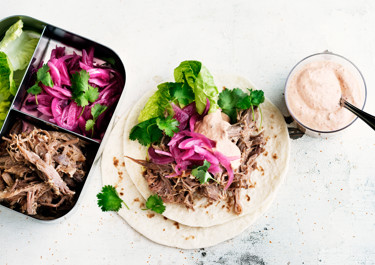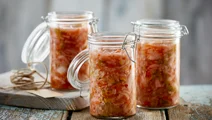Carnitas
&format=webp)
While carnitas is directly translated as 'little meats', there is nothing little about this Mexican favourite. Packed with flavour, the dish is a low and slow one with pure magic as result: Fall-apart-tender pork that is crisped to golden perfection, then wrapped in a warm tortilla before its final disappearing act from everyone's plates.
Ingredients
|
1 tbsp
Smoked paprika powder
|
|
|---|---|
|
600 g
Boneless pork shoulders
|
|
|
1 tbsp
Chilli flakes
|
|
|
1 tbsp
Ground ginger
|
|
|
2 tsp
Salt
|
|
|
1
Orange
|
|
|
3
Garlic cloves
|
|
|
2
Red onions
|
|
|
50 ml
White vinegar 12%
|
|
|
90 g
Caster sugar
|
|
|
150 ml
Water
|
|
|
8
Tortillas
|
|
|
Salad mix
|
|
|
200 ml
Sour cream
|
|
|
Fresh coriander, chopped
|
|
|
300 ml
Cola
|
Instructions
Step 1
Step 2
Step 3
Step 4
Step 5
Step 6
Step 7
Step 8
Step 9
Step 10
Questions about carnitas
Indulge in this amazing Mexican dish following this recipe, and keep reading if you want to learn more about the most frequently asked questions about it.
How do you know when carnitas are done?
The best way is to check the internal temperature. Perfect tenderness and juiciness are found between 90°C and 92°C. That's when the tough and rubbery connective tissues have melted away and dissolve into the meat. If you don't have a thermometer, it's the point where the meat falls apart by itself, basically when your mouth starts to water uncontrollably.
Can you overcook carnitas?
Definitely. If the internal temperature goes above 98°C the muscle fibres will toughen up again, making the meat dry and difficult to chew. If you have overcooked the meat, try adding some leftover stock.
Why do people put milk in carnitas?
Though it's not a traditional ingredient when cooking carnitas, some cooks like to add milk to their recipe. Milk helps to tenderise the meat and break down the tough connective tissues during the cooking process. It also enhances the richness of the flavour, adding a sweet, creamy tinge to the meat.
How do you keep carnitas from drying out?
The biggest culprit of dry carnitas is overcooking. Our three top tips are: Cover the meat with aluminium foil during the cooking process, keep your oven between 100°C and 120°C, and be vigilant during the last few hours when the risk of drying out is higher.
At what temperature should I cook carnitas?
Low and slow is where the magic happens. The perfect cooking temperature is between 100°C and 120°C. For added texture, you can crisp up the shredded meat by placing it under the broiler for a few minutes or giving it a quick fry in a skillet.
Carnitas: Mexican soul food at its best
When it comes to the best street food in the world, carnitas is ranked amongst the most popular recipes and it's little wonder why. A Mexican staple, this mouth-watering pulled pork has a depth of flavour that is hard, if not impossible, to replicate. Combined with a fresh lightness from toppings like coriander and lime, this dish gets a perfect 10.
Try these toppings
From salsa and guacamole to fresh coriander and grated cheese, your topping options are as endless and adventurous as you choose. The most traditional combination is finely chopped raw onion, fresh coriander and a squeeze of lime.
How to serve carnitas
The traditional way of serving carnitas is on a tortilla. With so many varieties available – from gluten free to paleo – it remains one of the most popular ways of serving this Mexican favourite. Other options include hard-shell tacos, burritos or even lettuce leaves as a light and healthy alternative.








